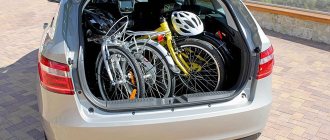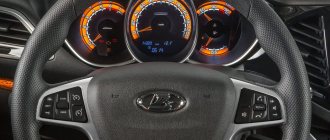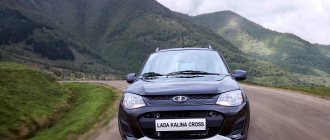Many domestic car enthusiasts appreciate all-wheel drive.
It guarantees higher cross-country ability of the car in frankly bad road conditions and reduces the risk of unpleasant parking in remote areas while waiting for a tow truck or at least a passing driver who can pull the car with a cable. The very expression “Lada Vesta jeep” is fundamentally erroneous - the all-wheel drive Lada Vesta Cross is a large all-terrain station wagon.
In addition, the error in interpretation lies, perhaps, due to the adjacent model released in 2016 - the Lada X-Ray is a high hatchback, which will also be presented in an all-wheel drive version (more precisely, even in two - with switchable 4x2 all-wheel drive and with constant 4x4). Also in the near future, a new Lada model is expected to appear, which claims to be an SUV: the Lada Vesta Cross. The launch of production of this model is one of the most anticipated events of the fall of 2016 (it is at this time that Bo Andersson plans to launch mass production of the Lada Vesta Cross). What is remarkable about this model will be interesting for everyone to know.
Specifications
The most important, in the opinion of almost every Russian car enthusiast, nuance that can characterize any car is its technical characteristics. With regard to the functional and productive SUV Lada Vesta, this statement is one hundred percent true.
In terms of its level of performance, the new all-wheel drive Vesta threatens to trample on the high position of foreign SUVs in the domestic market, despite the overall discrepancy between the body and the selected class. The Lada Vesta Cross will be delivered exclusively in a station wagon (five-door), contrary to the assurances of some experts and print media.
As for the power units of the model, the choice here will be quite small. A fairly powerful VAZ engine was chosen as the engine - a sixteen-valve, 1.8-liter, rated power of 123 horsepower (it is also possible to boost it to 140 hp by installing turbocharging, the manufacturer especially notes). The transmission used will most likely be supplied in the same form as for the Lada Vesta sedan (French five-speed “Euro” in both manual and AMT form).
The vehicle's ground clearance will become higher due to the claim of increased cross-country ability; The increase in size will most likely also affect the rims. The regular Lada Vesta station wagon will be somewhat squat than the Lada Vesta SUV. The suspension will undergo some fundamental changes and will receive significantly better shock absorption.
In general, the car’s power makes a pleasant impression on both ordinary people and experts inspired by the success of the sedan released in November 2015 (video of test drives can be seen here). However, it will be possible to say for sure whether the model will be successful only by adequately assessing the actual production model, since the experience of the updated AvtoVAZ indicates the possibility of improvements and alterations to existing concepts.
Exterior of Lada Vesta Cross SV
The design of the new Lada Vesta SV station wagon was developed by a team of specialists led by Steve Mattin. Every detail of the body is in harmony with each other, reminiscent of the “shark” theme in individual strokes. These features include the antenna “fin” located on the roof, as well as a plastic trim on the C-pillar, which becomes like a shark fin due to the visual gap with the roof. The narrowed pillars are in some places made in a black palette, which makes them invisible against the background of tinted glass. These details are successfully emphasized by the developers and complement the overall image. The car has a characteristic X-shaped style. Photos and videos are presented at the end of the review.
The roof also has a new shape, as it now has a significant slope towards the rear, which makes the car look like a representative of the sports class.
The dimensions of the Lada Vesta SV Cross fit exactly into the established framework of a platform sedan. The luggage compartment capacity, judging by the overall dimensions, is not much more compared to the four-door model. It has a lot of drawers for storing hand luggage, as well as additional fastenings. The volume is 480 liters when measured to the height of the curtain. In the floor under the lid there is a compartment with two removable trays, which adds another 95 liters. If you fold the back of the sofa, you can achieve maximum space with a usable volume of 825 liters.
Only the body height has become larger. In the Lada Vesta SV version, the parameters are increased thanks to the roof rails. She has them in black, while Cross has them in a metallic shade. The SUV has also added 2.5 cm thanks to the ground clearance, which is now 20.3 cm instead of 17.8 in the old variation.
In the Lada Vesta SV Cross, overall dimensions are not the only changes in the external design. The domestically produced vehicle is equipped with:
- 17-inch alloy wheels;
- protective plastic “skirt” around the entire perimeter of the body;
- original bumpers with imitation steel protection;
- stylish headlights;
- double exhaust pipe, which has a square cross-section;
- On the rear bumper there is a cutout for the muffler.
By the way, thanks to all the body kits, the off-road Lada SV has increased its length by 1.5 cm and its width by almost two, which can even be noticeable from photographs. The Cross has five seats, as well as doors. There is no video review from the test drive yet.
The developers tried to correct all the shortcomings of the Vesta sedan, in particular, the new cars will have an external trunk release button and a lockable gas tank flap.
Also included in the update is the color scheme. Now there is a new orange color, which is called Mars and is distinguished by its saturation. The black body kit highlights it favorably. A platinum color called Carthage has also been added.
Options
As for the richness of the proposed configurations, there are still a lot of questions. Some experts argue that the configuration of the Lada Vesta SUV will be identical to the optional packages offered to the buyer for the sedan already on sale. However, a year and a half (that’s how long it will take, in the best case, to develop and test the model) is quite a long time, and something can change radically.
However, photos of the Lada Vesta sedan configurations can be taken as the most reliable fact. According to Andersson, Vesta turned out to be a very successful car, eclipsing all domestic models of the previous ten years.
The only nuance that causes some concern among Russian car enthusiasts is the price of the much-anticipated new product. Due to the use of some imported components, the price of the car can seriously increase (this happened with the sedan, the price of which increased by about a quarter compared to what was announced at the beginning of 2015). In addition, all-wheel drive coupled with a displacement engine will show a completely different level of fuel consumption, which will indirectly increase the “operating cost” of the car.
All that remains for the Lada Vesta SUV is to wait for the pleasant (or not so pleasant) news that regularly leaks to the masses after conversations between the concern’s designers and journalists and experts.
More details about Lada “Vesta” cars
LADA SUV class, the concern’s new product – “Lada Vesta” jeep
Among the cars that came off the assembly line of the AvtoVAZ concern, only representatives of the 4x4 family are considered full-fledged SUVs.
In 2022, 13 Lada models with increased cross-country ability will be produced. Lada XRay and all Cross variants have a ground clearance above 190 mm. Real SUVs include the 4x4 family (Niva), which includes the Chevrolet NIVA. The official website offers concepts with a focus on off-road driving. In December 2019, the first renderings of the Lada Vesta jeep were leaked onto the Internet. According to the concern, the Lada Vesta SUV will not be inferior to the Niva in cross-country ability, providing the comfort of a family car.
High-slung Lada cars
These include Lada models: “Vesta Cross” and “Vesta SV Cross”, “Granta Cross”, “X-Ray” and “X-Ray Cross”, “Largus Cross” and “Largus Cross CIS”.
Appearance
At the front of the X-Rays and Wests is an easily recognizable black "X". On both sides there is a side stamping in the shape of the same letter. The headlights are complemented by LED daytime running lights. At the rear there are lights of a complex design and the inscription “LADA”. XRay and Vesta are equipped with an unpainted plastic body kit along the bottom of the car body, protecting the paintwork. The paint is not damaged when driving on rocky roads and off-road. Granta Cross has almost the same design, with the exception of the side stampings.
Station wagons "Largus Cross" and "Largus Cross CIS" are long-wheelbase models with increased capacity and cross-country ability. The front and rear bumpers, wheel arches and sills received plastic covers. The headlights look dated due to the lack of LEDs.
Salon
When looking at the front panel of the Lada Vesta Cross and Lada Vesta SV Cross, its futuristic design catches your eye. Optional features include the presence of bright orange or blue inserts (depending on body color).
The interior of the Granta Cross is copied from the previous version of the family. Bright inserts are the main detail that distinguishes the cross version from the mother model.
Interior of Granta Cross. Photo source: https://autogoda.ru/test-drives/lada-granta-cross-krasota-na-proselke/
The interior of the Lada XRay is trimmed with plastic. Specimens made in light and dark colors enter the market. The front seats seem short to many owners, and the second row is cramped, but the upholstery material is of high quality. Seamless technology was used in the manufacture of the front panel. The top-end XRay Cross received orange inserts in the interior design, improved sound insulation and heated rear seats.
The interior of the Lada Largus Cross and Largus CIS is offered in two versions: classic gray and with bright orange inserts.
Specifications
"Vesta Cross" and "Vesta SV Cross" inherited from the mother model the line of installed engines and gearboxes (5-speed automatic transmission and manual transmission). Maximum speed – up to 170 km/h. In the city, fuel consumption per 100 km is 9.6 liters. There are models with Jatco JF015E variator.
The Grants Cross transmission is represented by a 5-speed manual transmission and manual transmission. Engine volume – 1.6 liters. Lada Granta Cross reaches a speed of 166-178 km/h. Urban consumption – from 8.7 liters per hundred kilometers. In June 2022, information appeared that AvtoVAZ plans to equip the next generation Lada Granta Cross with a CVT.
Lada XRay is equipped with a 5-speed manual and robotic transmission, as well as a continuously variable transmission. At the car dealership you can buy an X-Ray with an engine capacity of 1.8 or 1.6 cubic meters, giving a maximum speed of 172 and 186 km/h, respectively. City gasoline consumption is 9-9.7 liters. In the crossover version, the car is equipped with a manual transmission, an automatic transmission and a CVT transmission. Under the hood you can find the development of AvtoVAZ (21179) or the brainchild of the Renault-Nissan concern (N4M). In the first case, the maximum declared speed is 180 km/h, in the second – 162 km/h. Passport consumption in the city per hundred kilometers is 9.1-9.7 liters.
The Largus Cross is equipped with a 1.6 liter petrol engine, which allows it to reach 167 km/h. The Largus Cross CNG engine runs on two types of fuel. The maximum speed on gas is 155 km/h, on gasoline – 159 km/h. Both members of the Largus family have a 5-speed manual transmission. Gasoline consumption per 100 km in urban driving for Largus Cross is 9.5 liters, Largus Cross CIS is 9.9 liters. A number of owners independently install a variator under HBO.
"Largus Cross". Photo source: https://zen.yandex.ru/media/maxauto/lada-largus-mnogo-za-malo-5d39531a520a9b00ad2a4ce3
The installed options include:
- emergency warning system "Era-Glonass";
- ABS;
- hill start assistance;
- MMS with navigation;
- side mirrors with built-in turn signals.
Analogs
Among the rivals of Lada models with high ground clearance:
- Renault Duster (from 750 thousand rubles). The disadvantages of the model include poor sound insulation, uncomfortable seats and massive sills. Positive features: comfortable suspension, ground clearance 205 mm, good handling.
- Renault Kaptur (from 960 thousand rubles). The Russian-assembled model has high ground clearance (204 mm), reliable suspension, and good sound insulation. Buyers are offered several design additions that allow them to personalize the car. Among the shortcomings are weak power steering, inconvenient visibility due to the wide A-pillars, and the interior is trimmed with cheap plastic.
- Renault Sandero Stepway (from 770 thousand rubles). “Sandero Stepway” attracts with its interior decoration, high-quality optics (head and fog), and the presence of climate control. Among the negative aspects are short “original” wiper blades, poor sound insulation, low door openings.
- Lifan X60 (from 740 thousand rubles). The Chinese car fits well on Russian roads. The suspension overcomes dirt roads and bumps without any complaints. The car starts without problems in -25 frost, but it takes a lot of time to warm up. The interior upholstery is wear-resistant. Weak points - gearbox, sound insulation, paintwork.
- Hyundai Creta (from 975 thousand rubles). The car embodies comfort, safety and ergonomics. Disadvantages: cheap finishing materials, poor sound insulation.
- Suzuki SX-4 (from 1.4 million rubles). The minimalism of the front console is a controversial detail of the Suzuki ESIx-4, which has both supporters and opponents. But the wide A-pillar, which blocks the view, the short rear wiper, and the uncomfortable driving position are almost unanimously recognized as disadvantages. A wide package of options is offered in the basic configuration.
In price comparison, most of its analogues are inferior to Lada.
Comparative sizes of Lada models with high ground clearance
To overcome off-road conditions, it is not enough to have high ground clearance. The clearance of the Lada X-Ray Cross is 215 mm, versus 200 mm for the Lada 4x4, but only the latest model belongs to the SUV class, while the XRay Cross is considered a crossover. The main difference between these two types is the presence of all-wheel drive in the jeep.
"Lada Vesta XRay Cross". Photo source: https://www.drive2.com/o/b/517045893791220393/?page=0
The main dimensions of the Lada 4x4 SUV, the Vesta SW Cross station wagon, the X-Ray crossover and other models are summarized in Table 1. Concepts such as the Lada Vesta SUV are not presented.
Table 1. Dimensions of Lada cars with increased ground clearance.
| Execution | Body | Ground clearance, mm | Trunk volume, l | Standard wheel size, inch | |||
| Type | Length, m | Width, m | Height, m | ||||
| Vesta Cross | sedan | 4,4 | 1,8 | 1,5 | 203 | 480 | 17 |
| Vesta SW Cross | station wagon | ||||||
| Granta Cross | station wagon | 4,1 | 1,7 | 1,6 | 198 | 355 | 15 |
| XRay | crossover | 4,2 | 1,8 | 1,6 | 195 | 361 | 16 |
| XRay Cross | crossover | 215 | 17 | ||||
| Largus Cross | station wagon | 4,5 | 1,8 | 1,7 | 195 | 560 | 16 |
| Largus Cross CNG | station wagon | 300 | |||||
| 4x4, | SUV | 3,7 | 1,7 | 1,6 | 200 | 265 | 16 |
| 4x4 Urban, | SUV | 3,6 | |||||
| 4x4, | SUV | 4,2 | 420 | ||||
| 4x4 Urban, | SUV | 4,1 | |||||
| 4x4 Bronto | SUV | 3,7 | 1,7 | 240 | 265 | 15 | |
| Chevrolet NIVA | SUV | 3,9 | 1,8 | 1,7 | 200 | 320 | 15 |
The given characteristics may differ slightly due to the optional installation of wheels of a different size.
Economic component
The release of the Lada Vesta with all-wheel drive is significantly limited by financial and economic indicators, which are very unstable in the domestic market. The plant is heavily dependent on government subsidies and additional injections. In any case, problems of a financial nature make themselves known, which significantly affects the efficiency and productivity of the enterprise.
For example, the release of the hatchback was moved forward a couple of years, which may have been due to a breakdown in economic ties associated with problems in neighboring countries. Such a delay in the release of the advertised model sowed some panic among potential buyers. There is information that the Lada Vesta with all-wheel drive will be produced exclusively on the basis of the existing station wagon. How justified this is, time will tell.











